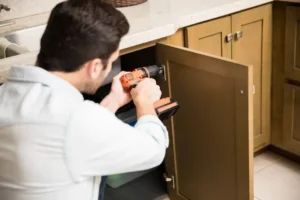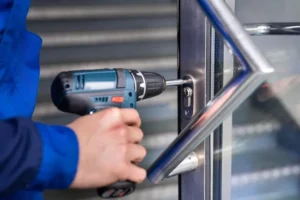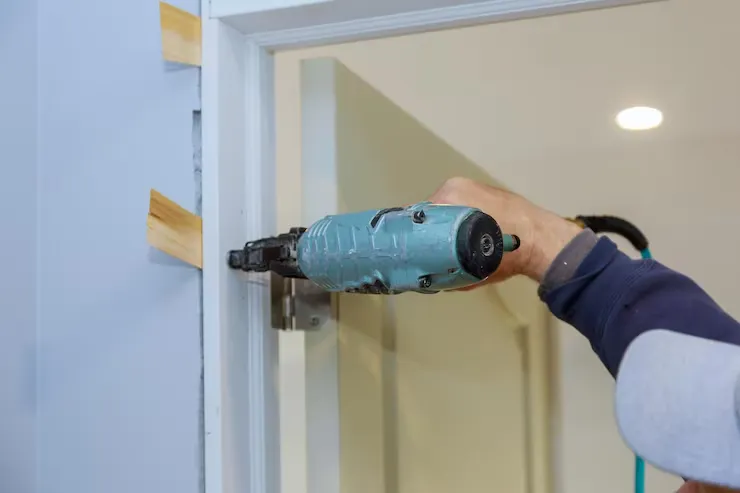

We fix cracks, alignment issues, and faulty closers to keep your storefront secure and welcoming.
Restore strength and durability to your facility’s metal or steel doors with professional welding and frame alignment.
From warping to hardware replacement, we ensure your office doors function flawlessly and look professional.
We service and repair automatic sliding, swinging, and revolving doors, ensuring smooth operation, proper sensor function, and reliable safety for both customers and employees.
We inspect and repair fire-rated doors to ensure your building meets all safety and fire-code requirements.
Eliminate slamming doors or sticking issues with precision hinge adjustments and high-quality closer replacements.

Serving Orange County businesses for years with unmatched door repair and security expertise.
Our emergency team is ready round-the-clock to fix urgent door issues and restore your business operations quickly.
All repairs are handled by licensed professionals trained in both mechanical and electronic door systems.
We back our repairs with warranty coverage, ensuring your satisfaction and peace of mind.
Don’t just take our word for it — hear from the families and businesses we’ve helped. Our commitment to excellence has earned us hundreds of five-star reviews and countless referrals. From emergency situations to planned security upgrades, our customers consistently praise our professionalism, reliability, and fair pricing.
EXCELLENTTrustindex verifies that the original source of the review is Google. Professional , Good personality, and did a good job as described fixing my key ignitionPosted onTrustindex verifies that the original source of the review is Google. Berry helpful helped diagnose the fact I needed a esl and fixed it fast and cheaper then anyone elsePosted onTrustindex verifies that the original source of the review is Google. If you are after Mercedes Benz keys this is definitely the place to come. I have a 2012?Mercedes Benz E550 UMatic and wanted a key. I called the Mercedes Dealer first. They quoted me close to a $1000 for a key and I had to make a service appointment. I called several Locksmith companies and they told me this car had special security features and the only place to get the key was the dealer. Then I was fortunate enough to contact Golden Locks. I was able to get my key in 1/2 hour for close to 1/4 of the pierce the Dealer quoted. I ended up getting 2 keys. Don’t waste your time. This company has great prices and very professional service.Posted onTrustindex verifies that the original source of the review is Google. I definitely recommend this place. Fast, reliable and they come to you. If you have an issue after your lock is replaced, they come back out and fix it. They are an honest company and are good at what they do!Posted onTrustindex verifies that the original source of the review is Google. The team is great and responsed quickly to all the questions I had. I had ordered a replacement lock for my patio door, the supplier was taking too long to ship the part so the team built me a lock and shipped it quickly to me. The lock works great. Great customer service!Posted onTrustindex verifies that the original source of the review is Google. Omar- Thank you for coming to our rescue. Your employee hiked a fence to find an open window into my parents house and fixed the broken lock like a pro. We really appreciate the extra effort he made to help us. You are the best.Posted onTrustindex verifies that the original source of the review is Google. Exceptional Service! I called late in the day to order a replacement lockset. I needed to schedule an installation and to balance the door hinges. It’s a metal and glass residential door. He came the next morning and repaired everything. I highly recommend Golden Locks!Posted onTrustindex verifies that the original source of the review is Google. We had a 22-year-old Hoppe lock mechanism that had quit working, and I found this business from Hoppe. When I wrote to customer service, I got an immediate reply, and the person stayed with me for half an hour or more, asking pertinent questions and explaining clearly how to take the measurements and photos that they needed in order to find the right set. I don't think I have ever, in my 82 years, had such excellent service!Posted onTrustindex verifies that the original source of the review is Google. They were a phenomenal help tracking down an obscure lock set. Great personal service, could not have found the correct parts without their time and help.Verified by TrustindexTrustindex verified badge is the Universal Symbol of Trust. Only the greatest companies can get the verified badge who has a review score above 4.5, based on customer reviews over the past 12 months. Read more

Based on 400+ Google Reviews
Misaligned frames or latch issues can prevent your door from closing securely we realign, adjust, and restore smooth operation.
Bent frames or worn hinges can cause doors to sag or stick; our technicians repair or replace them for long-lasting stability.
Humidity, uneven floors, or misalignment often lead to dragging doors; we fine-tune or rehang them for effortless movement.
Whether due to wear, damage, or key issues, we repair or replace faulty locks to restore full functionality and security.
We troubleshoot and recalibrate automatic sensors to ensure doors respond accurately and safely every time.
Hydraulic door closers lose control over time we adjust or replace them to stop loud slams and keep entry smooth and quiet.
Simple steps to avoid costly lockout situations and maintain business security